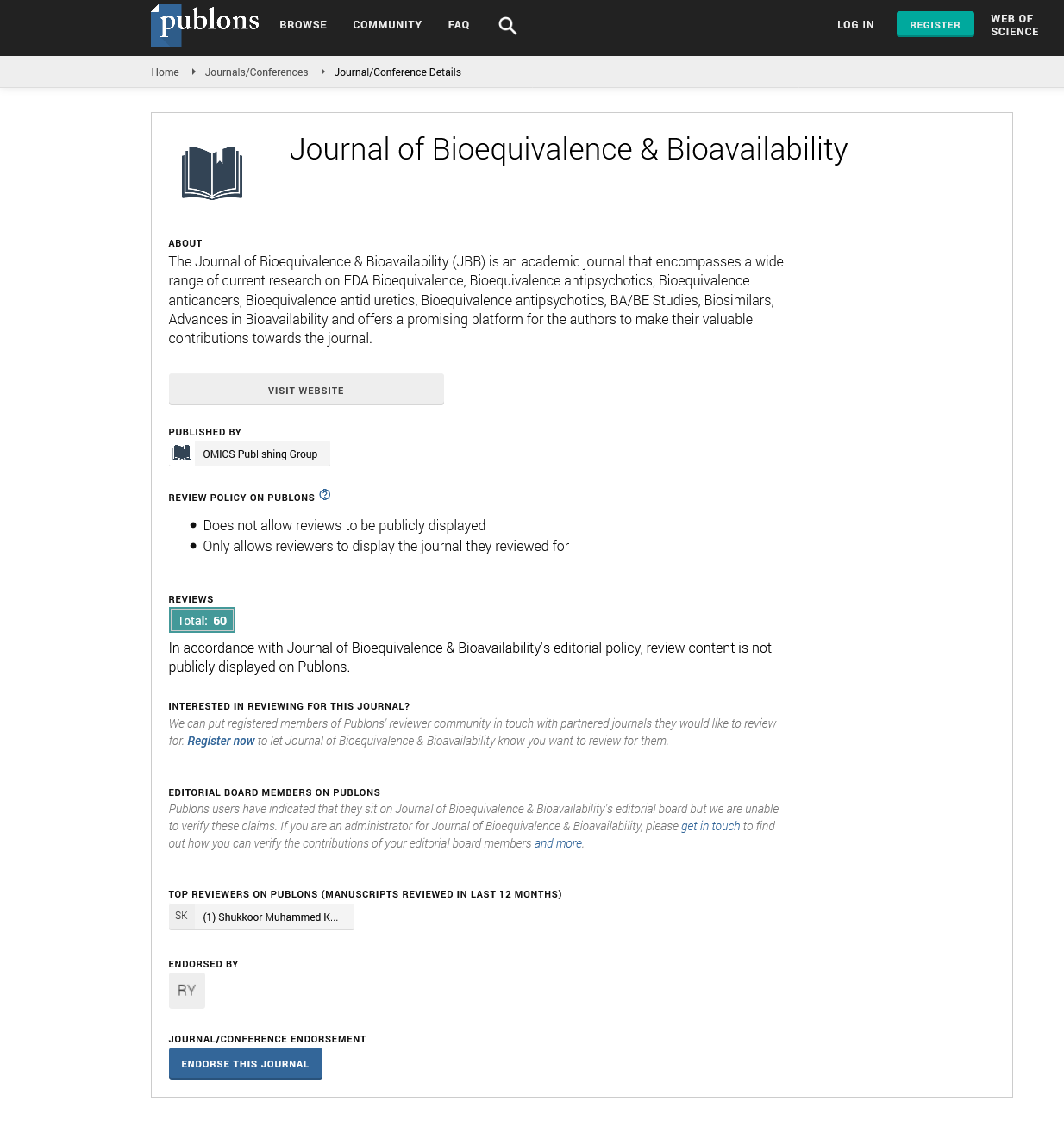Indexed In
- Academic Journals Database
- Open J Gate
- Genamics JournalSeek
- Academic Keys
- JournalTOCs
- China National Knowledge Infrastructure (CNKI)
- CiteFactor
- Scimago
- Ulrich's Periodicals Directory
- Electronic Journals Library
- RefSeek
- Hamdard University
- EBSCO A-Z
- OCLC- WorldCat
- SWB online catalog
- Virtual Library of Biology (vifabio)
- Publons
- MIAR
- University Grants Commission
- Geneva Foundation for Medical Education and Research
- Euro Pub
- Google Scholar
Useful Links
Share This Page
Journal Flyer

Open Access Journals
- Agri and Aquaculture
- Biochemistry
- Bioinformatics & Systems Biology
- Business & Management
- Chemistry
- Clinical Sciences
- Engineering
- Food & Nutrition
- General Science
- Genetics & Molecular Biology
- Immunology & Microbiology
- Medical Sciences
- Neuroscience & Psychology
- Nursing & Health Care
- Pharmaceutical Sciences
Opinion - (2025) Volume 17, Issue 2
Clinical Trial Design for Narrow Therapeutic Index Drugs in Bioequivalence Studies
Ned Baraeon*Received: 03-Apr-2025, Manuscript No. JBB-24-28987; Editor assigned: 07-Apr-2025, Pre QC No. JBB-24-28987 (PQ); Reviewed: 21-Apr-2025, QC No. JBB-24-28987; Revised: 28-Apr-2025, Manuscript No. JBB-24-28987 (R); Published: 05-May-2025, DOI: 10.35248/0975-0851.25.17.634
Description
Clinical drug trials represent a cornerstone of evidence-based medicine, providing the foundational data needed to ensure the safety, efficacy, and overall therapeutic reliability of pharmaceutical products. Within this landscape, bioequivalence studies play a critical role, especially in the development and approval of generic drugs. The concept of bioequivalence ensures that a generic drug matches its branded counterpart in terms of absorption rate and extent, which directly influences the drug’s therapeutic effect. The importance of clinical drug trials in establishing bioequivalence has grown exponentially over the past few decades, as healthcare systems strive to balance cost-efficiency with uncompromising clinical standards.
The proliferation of generic drugs, driven largely by the economic imperatives of reducing healthcare expenditure, has made bioequivalence not just a scientific benchmark but a regulatory necessity. Unlike new drug trials that demand extensive preclinical studies, multiple phases of clinical testing, and long-term safety assessments, generic drugs are typically subjected to streamlined approval pathways, with bioequivalence serving as the main gatekeeper. Through well-structured clinical drug trials, bioequivalence is demonstrated by comparing pharmacokinetic parameters such as Cmax (Maximum Plasma Concentration), tmax (Time to reach Maximum Concentration), and AUC (Area Under the concentration-time Curve) between the generic and the reference product.
Although bioequivalence trials are generally more cost-effective and faster than full-fledged new drug trials, they are no less critical in ensuring therapeutic parity. A generic product may contain the same active ingredient as its brand-name counterpart, but subtle variations in excipients, manufacturing processes, or release mechanisms can influence its pharmacokinetics. The clinical drug trial acts as a safeguard against these differences affecting therapeutic outcomes. Regulatory agencies such as the U.S. Food and Drug Administration (FDA), the European Medicines Agency (EMA), and others have established stringent criteria for bioequivalence that must be met through statistically powered, well-designed crossover studies, typically involving healthy volunteers.
One of the most discussed aspects of clinical drug trials in bioequivalence is the inherent challenge posed by Narrow Therapeutic Index (NTI) drugs. These are drugs where small deviations in plasma concentration can lead to subtherapeutic effects or toxicity. Clinical trials for NTI drugs often require tighter limits, more complex study designs, and sometimes even therapeutic equivalence trials in patients to adequately demonstrate that the generic is just as safe and effective as the innovator drug.
Ethical considerations in clinical drug trials for bioequivalence cannot be overlooked. Although these studies are generally low-risk, since both the generic and reference products are already approved, they must still adhere to strict ethical guidelines. Informed consent, subject safety, data privacy, and adherence to Good Clinical Practice (GCP) standards are non-negotiable. In developing countries, where many bioequivalence studies are outsourced due to lower costs, regulatory oversight must be particularly vigilant to prevent ethical lapses and ensure the credibility of trial data. Exploiting cost advantages should never come at the expense of scientific integrity or human rights.
Another aspect worth exploring is the post-approval phase. While bioequivalence trials provide critical pre-approval data, they offer a limited view of long-term safety and efficacy. This is where post-marketing surveillance and real-world evidence come into play. Adverse drug reaction reporting systems, electronic health record analyses, and patient-reported outcomes can help verify whether the bioequivalent drug maintains its expected clinical performance over time. These real-world data sets can sometimes reveal discrepancies not evident in tightly controlled trial environments, thus serving as a vital complement to the initial bioequivalence findings.
Technological advancements are reshaping how clinical drug trials in bioequivalence are conducted. Innovations in pharmacokinetic modeling, Physiologically Based Pharmacokinetic (PBPK) simulations, and machine learning algorithms are enabling researchers to predict drug behavior with greater accuracy and efficiency. These tools can reduce the reliance on extensive human trials, lower costs, and expedite the regulatory process. However, integrating these technologies into regulatory frameworks requires careful validation, standardization, and global consensus to ensure consistency in drug evaluation standards.
Citation: Baraeon N (2025). Clinical Trial Design for Narrow Therapeutic Index Drugs in Bioequivalence Studies. J Bioequiv Availab. 17:634.
Copyright: © 2025 Baraeon N. This is an open-access article distributed under the terms of the Creative Commons Attribution License, which permits unrestricted use, distribution, and reproduction in any medium, provided the original author and source are credited.

